
- Index
- Framing
- Listed By
- Material
- Style
- Abstract (20)
- Abstract, Modernism (6)
- Americana (5)
- Art Deco (9)
- Art Nouveau (5)
- Art, Realism (4)
- Dutch (5)
- Dutch, Realism (5)
- Expressionism (29)
- Folk Art (10)
- Impressionism (165)
- Impressionist (5)
- Modernism (13)
- Portraiture (7)
- Realism (182)
- Still Life (22)
- Traditional (10)
- Traditional, Realism (4)
- Victorian (22)
- Vintage (60)
- Other (564)
- Subject
- Type
RARE Antique New York Impressionist Oil Painting, Arthur Fitzwilliam Tait'85
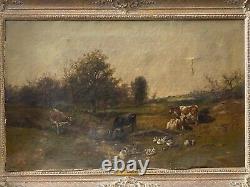
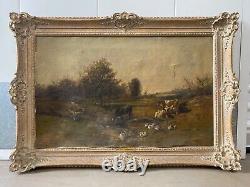
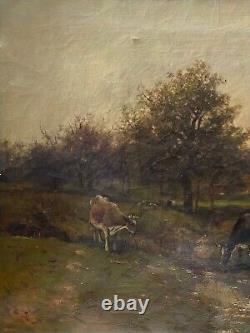
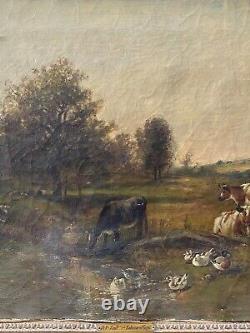
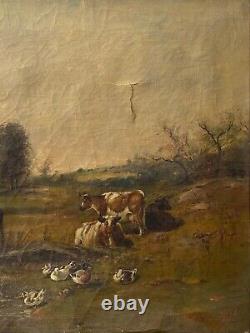
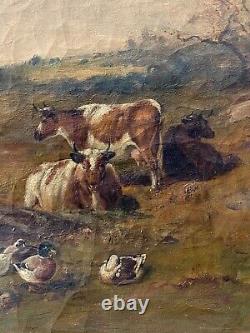
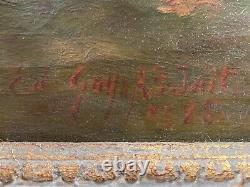
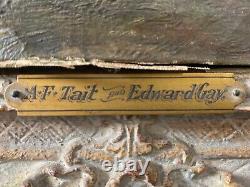
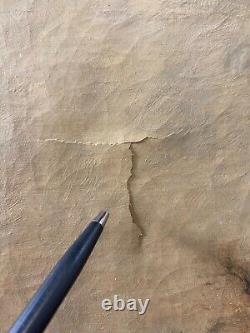
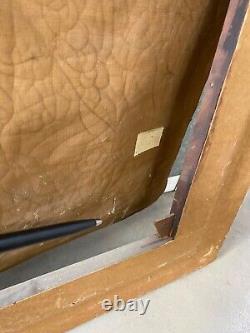

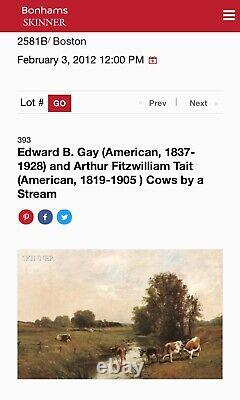


This is a very Important and RARE Antique New York Impressionist Oil Painting on canvas, which is a collaborative work by renowned early New York artists Edward B. Gay (1837 - 1928) and Arthur Fitzwilliam Tait 1819 - 1905. This work depicts a rural landscape scene (presumably painted by Gay), with various waterfowl and cows which are clearly by the hand of Tait, who was renowned for his finely rendered animal paintings. Signed and dated in the lower right corner (in Tait's handwriting and signature style): Ed. " Additionally, an old brass plaque affixed to the front of the frame reads: "A.
Approximately 22 3/4 x 32 3/4 inches including frame. Actual artwork is approximately 17 1/4 x 27 1/4 inches.
Good - Fair condition for over 100+ years of age, the canvas has separated from its edges on the bottom and left side please see photos carefully. There are also a few small tears, and age-related craquelure. This collaboration between these two important American artists seems to have only lasted one year and produced only two paintings.The only other comparable example to this work is "Cows by a Stream, " also dated 1885 and signed by the two artists. This very rare piece is absolutely worthy of a proper restoration and will only increase in value over time.
Acquired from an old estate collection in Los Angeles, California. If you like what you see, I encourage you to make an Offer. Please check out my other listings for more wonderful and unique artworks! 1905 - Yonkers, New York. Animal, game and domestic fowl and hunting scene painting. Arthur Fitzwilliam Tait (1819 - 1905). Born in Liverpool, England, Arthur Tait became America's first important sporting artist. In England, he trained as a lithographer for Agnews, an art dealer in Manchester, and taught himself to paint by copying works at the Royal Institute. He also assisted American Indian painter George Catlin, with his traveling Indian gallery that he had brought to England, and Tait was impressed with Catlin's subject matter and skill. In 1850, Tait came to America to pursue his interest in wildlife and hunting, sports that were closed to the public in aristocratic England.He worked primarily from a studio in New York City and never got west of Chicago. Becoming a skilled woodsman and marksman, he acquired excellent first-hand knowledge that he brought to his paintings.
As a result, his realistic genre hunting scenes, with their story-telling aspects, made him one of the 19th century's most popular painters. 1850 to 1860 was his most productive period, and his frontier paintings were taken as literal views although he never got west of Chicago. His colorful sporting and wildlife paintings were usually Adirondack Mountain scenes, which were popularized through thousands of Currier and Ives reproductions and Prang's chromolithographs. People loved the warm camaraderie of his hunting and fishing, cabin and campfire depictions, and he did much to focus public attention on natural scenery and wildlife. He also mastered game still lifes, that influenced a succeeding generation of artists including Michael Harnett. Tait's style was consistent and unchanging, and he had a long productive career until his death in 1905. Source: David Michael Zellman, 300 Years of American Art. Biography from the Archives of AskART. Gay (1837 - 1928) was active/lived in New York / Ireland. Edward Gay is known for Landscape, rural life, still-life and mural painting. He was active in Mt.Vernon, New York and Cragsmoor, New York. The 1848 Irish potato famine forced his family to move to America, when he was 11 years old.
Gay trained in Albany on the advice of James Hart, his brother William Hart, and George Henry Boughton, artists who recognized Gay's talent while he was still a child. In 1862, Gay went to Karlsruhe in Germany to continue his studies under the artists Johann Wilhelm Schirmer and Karl Friedrich Lessing. Gay and his wife, Martha Freary, moved to Mt. The couple had a son, Duncan-also an artist-and a daughter, Ingovar.Gay was a member of the New York Artists Fund Society, National Academy of Design, and the Lotos Club. He exhibited in museums and galleries throughout America and he painted murals for public libraries in Mt.
Vernon, New York and Bronxville, New York. Gay died in 1928 in Mount Vernon, New York. A prolific painter of landscapes, Edward B. Gay immigrated to America with his parents in the wake of the Irish Potato Famine in 1848.
Arriving in Albany, New York, the family's situation required him to go to work as a young boy. When he displayed a talent for drawing, he began study with select local painters, including George Boughton and the Hart brothers. In 1862, he went to Karlsruhe, Germany to continue his education under the conventional historical painters Johann Schirmer and Karl Frederich Lessing. Gay ultimately settled with his family in Mount Vernon, New York, where he painted the area's bucolic farmland, pastures and orchards. A summer home in upstate New York provided additional subject matter for his brush, as did regular trips to Europe and at least one visit to the South Carolina Lowcountry, as evidenced by this atmospheric canvas.
The artist's work is represented in the collections of the Metropolitan Museum of Art, Smithsonian American Art Museum, National Academy of Design, New-York Historical Society, and Gibbes Museum of Art. Edward Gay was born in Ireland and emigrated to the United States with his parents in 1848. The family setttled in Albany, New York.Gay began his artistic studies with James M. Hart in 1848 and undoubtedly found himself in the company of the group of prominent Albany artists in the 1840s, which included George Henry Boughton, William Hart, Erastus Dow Palmer, and Homer Dodge Martin. In 1868, Gay went to Europe to pursue his studies in Karlsruhe, Germany, returning to the U. He shortly thereafter moved to New York City and subsequently to Mt. Although he had begun painting in the Hudson River style, he became more of a Tonalist painter as his career developed, painting emotionally charged, low-light renderings of the landscape of Westchester County.
Gay enjoyed a long, successful career, becoming a member of the Century Association and the Union League Club in New York. He became an Associate of the National Academy in 1869 and was inducted as a full Academician in 1907. One of the more prominent members of the Cragsmoor art colony, he built a residence there in 1905.
Edward Gay died in Mt. Gay's work can be found in the collections of the National Academy, the Metropolitan Museum of Art, the Smithsonian American Art Museum, the National Gallery, the Munson-Williams-Proctor Arts Institute (Utica, NY), the Nelson-Atkins Museum of Art (Kansas City), the Smith College Museum, and the New York State Historical Society (Cooperstown, NY), among others. Date / Time: February 03, 2012 12:00PM. Signed and dated Edw Gay. Oil on canvas, 17 1/4 x 26 7/8 in. (43.5 x 68.5 cm), framed. Retouch to sky of u.Some areas of smoothed impasto to sky area due to lining; minor skinning to sky area; no additional condition issues to report.

